Sunday, May 11, 2008 | posted by dan bertolet | Comments Off on The West Slope Of First Hill

Long underutilized, but finally starting to see some more action. The above rendering shows the Landes Apartments, currently under construction at the corner of 8th and Marion. Designed by Baylis and NBBJ, developed by Harbor Properties, with 81 units, 3850 SF of retail, and 72 underground parking stalls. Just across the street on 8th Ave is the 17-story M-Street Apartments, with 220 units over a grocery store, which opened about a year ago.
But hold on, there’s something big missing in that Landes rendering, and that would be the building shown in the rendering below…
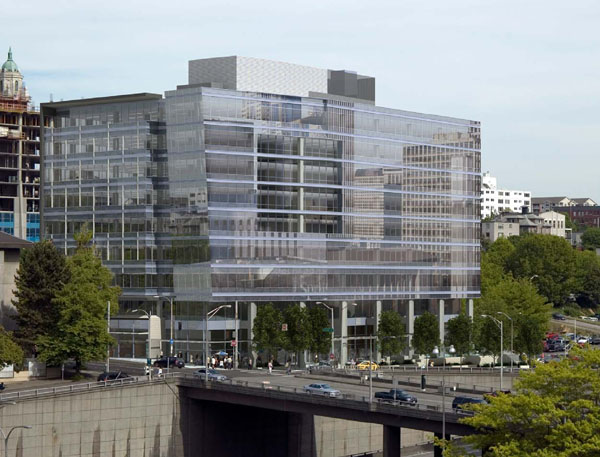
…namely, 7th and Madison, a 9-story, 200,000 SF office building developed by OPUS and designed by NBBJ, also currently under construction. Unlikely that anyone living in Landes will be seeing much of the WaMu Tower from their window.
It is curious how neither of these new projects maxes out the NC3-160 height limit. Perhaps OPUS didn’t want to block the views from M-Street, which it also owns. As for the Landes, Harbor may have opted not to build more than five stories above the concrete, since that would have precluded the use of wood frame construction.

Status as of early May is shown in the photo above. M-Street, visible to the far right, illustrates the available zoning envelope. It’s probably safe to assume that parking lot in the foreground will eventually sprout 160-foot tower(s), though nothing is planned yet as far as I know.

More action is in store two blocks east at 8th and Seneca: the 25-story, Seneca Towers (large pdf), rendered above, is scheduled to begin construction this summer. Designed by MulvannyG2, and developed by CA-based Laconia, the project will provide 285 condo units with 315 parking stalls.
And there’s more: a few blocks south, Skyline at First Hill, a full-block, 26-story “life care” project is currently under construction. More on this in a future post…
Saturday, May 10, 2008 | posted by PostModernDecay | Comments Off on Defending the SLUT

I’m a bit surprised at myself for writing this. But this is actually more about defending the idea of the SLUT, more than the actual SLUT itself. I know there is considerable suspicion that surrounds anything connected to Vulcan and it’s perceived influence on city matters. But this maybe a step in the right direction, at least on an ideological basis, as well as a reversal of trends that are more than vaguely criminal in origin.
James Howard Kunstler was in town a couple of weeks ago. I heard him on KUOW, plugging his new novel while explaining how the entire economic structure behind the automobile and the suburb is not sustainable and sooner than later it will fail. I decided to pick up a copy of his Geography of Nowhere and get more into his nasty details. Now I’m not totally sold on his more economic doomsday tone, but his history on the murder of municipal public transportation is very enlightening indeed.
It was is a complex criminal conspiracy involving the auto industry, the oil industry and tire companies that killed such things as the electric street car lines. And this is not one of those tin-hatted theories that one usually finds on badly designed webpages with atrocious grammar. General Motors was actually indicted and convicted of criminal conspiracy in 1949 for what they did to bring down the trolley system in Los Angeles.
Maybe something like the SLUT is simply a small step in the direction away from the ultimately dysfunctional residence pattern that was criminally foisted upon us by a small number of very wealthy individuals looking for even larger profits, ironically taken by a single, wealthy individual looking for larger profits. Not sure what to think about that…
Saturday, May 10, 2008 | posted by dan bertolet | Comments Off on Cars And Posthumanism Chapter 13: Loaded Pistol

[ “Do ya feel lucky, punk?” ]
(This post is part of a series: see Chapters 1, 23, and 37)
True story: A few days ago a neighbor of mine who’s a mother of four young children told someone who was driving too fast down her residential side street to slow down. In response, a person in the car aimed a pistol at her. Totally sick and twisted, but probably more a result of deep-rooted cultural issues than of the dehumanizing effects cars have on people.
What I find more revealing about how people devolve when they get behind the wheel of a car are the things average people do every day. My current pet example: people who run lights going red when there’s a crowd of pedestrians about to step off the curb to cross the street. I work in downtown Seattle and I see this multiple times pretty much every day. And especially for right turns — apparently many drivers believe there is a special rule that says you get an extra time window to blow a red if you are turning right.
It is undeniable that drivers who do this are taking a gamble on seriously injuring or killing someone. They are making a choice that saving a minute or two is worth this risk. But here’s the thing: Were they not intoxicated with the power of a big machine, these same people would do anything to avoid putting others at that sort of risk. Imagine a person walking in the street in front of a crowd of pedestrians waiting for the walk sign, and imagine, as the signal changes to “walk,” that person waving a big sword inches from the faces of the people standing there. This is in effect what drivers are doing when they push red lights.
The amazing thing is that not only are the drivers stripped of normal healthy human compassion by cars, but that the pedestrians put up with it with nary a complaint. No doubt most people are shocked and enraged to hear about an incident with a gun such as I described in the beginning of this post. So where’s the outrage when they are threatened to essentially the same degree by a driver in a car? Just another sad quirk of a culture enslaved, both mentally and physically, to cars.
Thursday, May 8, 2008 | posted by dan bertolet | Comments Off on Dearborn Street Development Conditionally Approved

The redevelopment of the 10-acre Goodwill site at 1400 South Dearborn St. has been conditionally approved (h/t Central District News). Read all the gory details here (pdf). Most significantly, the developer’s request for a contract rezone from 65 to 85 feet was granted, with the key condition that 400 residential units be provided.
This proposal has been controversial, as noted here. I continue to be decidedly ambivalent. I like it because it is much better use of the land, and it will be great to have new housing and retail on that site. But I also dislike it for several reasons:
- Overall, it’s just too damn big. Big developments inherently lack the diversity in building form, age, use, style, cost, etc. that are essential ingredients for a vibrant city.
- It’s overparked. 2300 parking stalls. And Seattle wants to be the greenest city in the U.S. Hello?
- The car-centric design deprives the development of the granularity that would more appropriate for an urban village. Ideally the street grid would extend through the site in both directions to allow maximum permeability for both cars and pedestrians. But the requirement for massive structured parking decks terminates the grid on the south and west. You have to walk up two flights of stairs to enter the site on foot from Dearborn.
- Oh, and apparently I’m in favor of banning big box stores from Seattle.

Wednesday, May 7, 2008 | posted by Joshua | Comments Off on … then we take Berlin
UPDATE: My apologies for the size of the pictures I posted yesterday. I’ve taken the sage advice of Josh and just posted them to Flickr. If any have interest in seeing them, let me know. Otherwise, treat this as a musing and go about your day.Â
Apropos of Dan’s Vancouver envy, I thought I’d share the object of my own recently developed inferiority complex: Berlin. A recent trip to that hugeasscity yielded the following pictures of public art, great architecture, and a generally thriving city (despite the paucity of white collar jobs).Â
A lot of these photos were taken in and around Potsdamer Platz, which has recently completed a massive redevelopment project, much of which was headed by Renzo Piano (the sleek triangular building below was also designed by him). Potsdamer was the busiest intersection in all of Europe during the 1920s and 30s (site of the first traffic light in Europe!), largely destroyed during WWII, and then completely razed during the 30 years it separated east and west Berlin (famously, a pack of rabbits were the only inhabitants light enough to not set off the mines). And now, this.
Also of note, most buildings built in Berlin are required to devote 1% of their budget to public art.
Â
Wednesday, May 7, 2008 | posted by Sivalinga | Comments Off on Global Gehry Asymptote
Tuesday, May 6, 2008 | posted by dan bertolet | Comments Off on WHAT ARE People FOR?
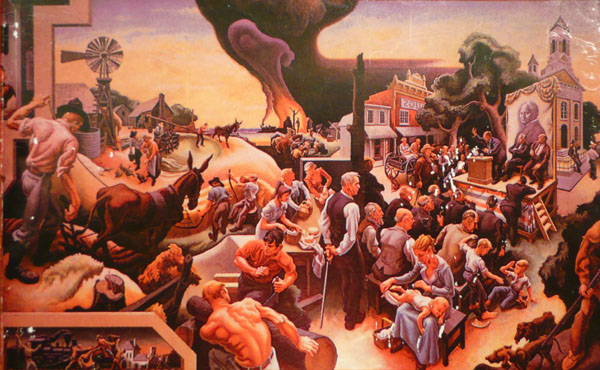
[ What Are People For? cover illustration: Politics, Law, and Farming in Missouri by Thomas Hart Benson ]
This collection of essays by Wendell Berry has the best book title ever. One of the essays is called “Why I Am Not Going to Buy a Computer.” But then, how does he blog?
On April 28 the Seattle City Council passed the Local Food Action Initiative. Nineteen years ago Berry wrote an essay called “The Pleasures of Eating,” in which he lists seven things urbanites can do to help mitigate the decline of farming and rural life in the U.S. Well Wendell, I guess we’re finally catching up with you. And so sorry that Michael Pollen is getting so much credit for ideas you (and others) wrote about decades ago. Alas, we Americans have a hard time paying attention to anyone who doesn’t have the intellectual stamp of approval of the New York Times.
- Participate in food production to the extent that you can. If you have a yard or even just a porch box or a pot in a sunny window, grow something to eat in it. Make a little compost of your kitchen scraps and use it for fertilizer. Only by growing some food for yourself can you become acquainted with the beautiful energy cycle that revolves from soil to seed to flower to fruit to food to offal to decay, and around again. You will he fully responsible for any food that you grow for yourself, and you will know all about it. You will appreciate it fully, having known it all its life.
- Prepare your own food. This means reviving in your own mind and life the arts of kitchen and household. This should enable you to eat more cheaply, and it will give you a measure of “quality control”: you will have some reliable knowledge of what has been added to the food you eat.
- Learn the origins of the food you buy, and buy the food that is produced closest to your home. The idea that every locality should be, as much as possible, the source of its own food makes several kinds of sense. The locally produced food supply is the most secure, the freshest, and the easiest for local consumers to know about and to influence.
- Whenever possible, deal directly with a local farmer, gardener, or orchardist. All the reasons listed for the previous suggestion apply here. In addition, by such dealing you eliminate the whole pack of merchants, transporters, processors, packagers. and advertisers who thrive at the expense of both producers and consumers.
- Learn, in self-defense, as much as you can of the economy and technology of industrial food production. What is added to food that is not food, and what do you pay for these additions?
- Learn what is involved in the best farming and gardening.
- Learn as much as you can, by direct observation and experience if possible, of the life histories of the food species.
— Wendell Berry, 1989
Monday, May 5, 2008 | posted by dan bertolet | Comments Off on Our Humble Neighbors To The North Are Also Leaving Us In The Dust

[ Dockside Green rendering: Busby, Perkins+Will ]
In case you haven’t already, you can add Canada to the long list of countries that are actually building the type of large-scale, cutting edge green developments that we here in the U.S. seem only capable of talking about.
Designed by Busby, Perkins+Will, Dockside Green, in Victoria, B.C. will be the greenest mixed-use neighborhood in Canada. You name the sustainability strategy, they’re applying it. And targeting LEED platinum for every building on the site. Etc, etc. I don’t have it in me to list all the green design features here, so it’s up to you to go read about it and weep.
Weep, that is, if you live in the U.S. — because you won’t find anything that even comes close to this project in your own country. Please do correct me if I’m wrong and there’s something new and amazing out there I don’t know about. And I’d also be curious to hear about projects people have come across that represent the best the U.S. has done so far.

[ Dockside Green rendering: Busby, Perkins+Will ]
Sunday, May 4, 2008 | posted by dan bertolet | Comments Off on The Viaduct Conspiracy

[ Seattle in 1925 ]
As the stakeholder committee gets into it, viaduct buzz is noticeably notching up. Local urban designer David Sucher, who has been relentlessly predicting a retrofit for years, recently reiterated his view here, but what caught my attention was his assertion that the government has been intentionally misleading the public — our local version of the Iraq War, as he put it.
A few months ago over at Crosscut, C.R. Douglas evoked similar suspicions in a blog post about the “myth” of unstable soil under the viaduct columns, questioning why he was only just learning that the viaduct “is on fairly stable footing.” The answer, of course, is that he hadn’t done his research. No such myth ever entered into any legitimate engineering analysis of the viaduct. Still, Sucher chimed in with a comment about the “conspiracy of silence.”
To paraphrase the conspiracy theory, if I may: Safety concerns and the cost of retrofitting were both dishonestly overstated by government officials in order to garner support for the tunnel option, which was then believed to be a big political winner. Now that the tunnel is off the table, these same officials have no choice but to pretend to entertain the possibility of the surface option, since they can’t reneg on their prior safety and cost claims. The surface option supporters play right into it because they’re such ideologues that they refuse to listen to even a word about a retrofit. But in the end, all that’s irrelevant anyway because the conspirators have perfect confidence that no consensus will be reached and the retrofit will become the inevitable fall back option. Capiche?
Meanwhile, Popular Mechanics just put the Alaskan Way Viaduct on its top ten list of “pieces of U.S. infrastructure we must fix now.”
Though it may sound like I’m being totally dismissive, I’m actually not. I’m not so naive as to believe such a thing could never happen. But this Sightline comment thread from two years ago all but puts it to bed for me. One study (Twelker/Gray) supports a relatively cheap retrofit, while multiple studies — including some that were conducted in Universities and have been peer reviewed — are in agreement about the high cost of retrofitting. Also, the first engineering study showing the high cost of a retrofit was done in 1995 “before the tunnel idea was even on the drawing board,” pre-Nickels, pre-Gregoire. I suppose the new administrations might be compelled to carry on the conspiracy to preserve the Party, but how far can you stretch this thing?
But still, I’m keeping on open mind on this. If any of you readers out there can point to concrete evidence on viaducty shenanigans, let’s have it.
Saturday, May 3, 2008 | posted by dan bertolet | Comments Off on Almost What We Don’t Build Anymore
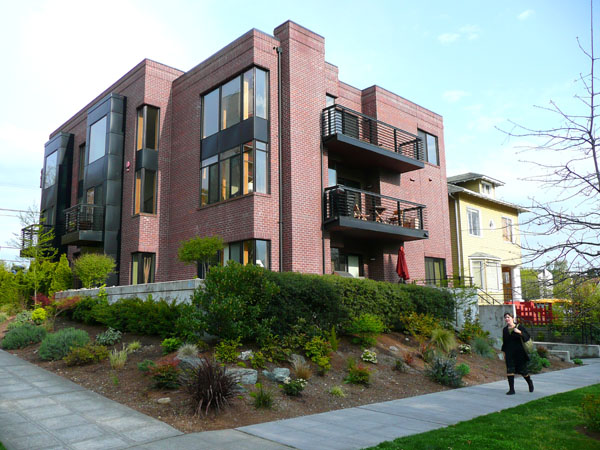
This is the Opal Condominiums at 16th and Pike, just a few blocks south of the older two-story apartment in discussed in this post. It has some obvious similarities. Why, in this case, did the developer not go with a townhouse 4-pack?
The Opal is three stories, with six units and underground parking (the parking entrance is off Pike at the south end of the building). My guess at why this project was feasible: the units are high-end and there is a small number of them. The selling price of the units was apparently high enough to offset the cost of building the underground structured parking. The slope of the site also helped. And with only six units, the number of stalls, and thus the parking area could be kept relatively small.
The Opal replaced a funky, 2-story early 20th-century house that was split up into four apartments. Rent was absurdly cheap — I know cause I lived there for a year in 1995. It had a shack of a garage off the alley that was mostly full of the owner’s junk. The residents parked on the street.
As this example demonstrates, the City’s parking requirement all but makes it inevitable that on small lots, developers will build low numbers of expensive units rather than higher numbers of affordable units. The proposed development at 1126 34th Ave in Madrona is another example. If expensive urban land is used to store cars, someone has to pay.
Requiring parking is in direct conflict with at least three of the City’s key sustainability goals: to provide affordable housing, to increase density, and to reduce car-dependence. Seattle residents who howl about parking whenever new development is proposed might do well to think a little more deeply about the big picture. If and when their constituents become more rational about parking, the City leaders will follow.
Thursday, May 1, 2008 | posted by dan bertolet | Comments Off on Sit Me Down

This is the open space in front of the Federal Courthouse at Stewart and 7th in downtown Seattle. It’s visually engaging. But is it a place that gets used much by people? It doesn’t look like there are enough good places to sit down, which, as William Whyte observed, is a major impediment to the success of any urban open space.
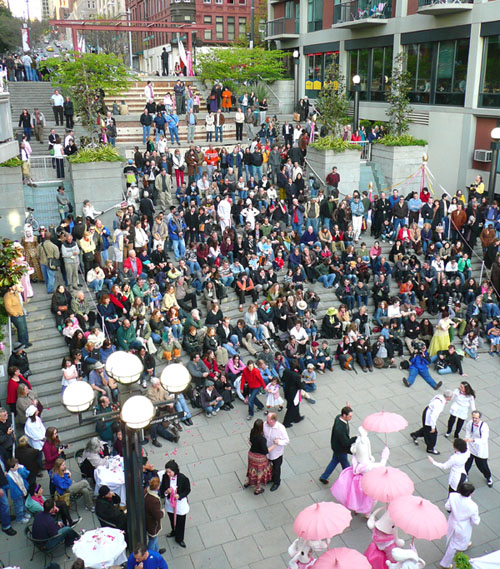
This is Harbor Steps, at First and University, during Site Specific Performance Network’s May Day extravaganza. Lots and lots of places to sit. Harbor Steps is a well populated open space, at least in the warmer/drier months, because it is so inviting and easy for people stop and take a load off.
Harbor Steps is the most usable and used open space in the downtown office core. But the City of Seattle can’t take much credit for it — Harbor Steps was privately developed and is privately owned. What could the City do to top Harbor Steps?
Thursday, May 1, 2008 | posted by dan bertolet | Comments Off on Two Things Americans Say They Don’t Like
Sprawl and Density.
This quip goes a long way towards summing up the gestalt of the Urban Land Institute’s Reality Check event, held April 30th on the UW Campus. See the Seattle Transit Blog for a detailed account of the event.
ULI’s Ed McMahon made the above quip in his keynote address, and it was later repeated by Mayor Nickels during a panel discussion. And it’s an excellent one on many levels. It pokes fun at wanting to have it both ways, how we want to have our cake and eat it too; It gives people credit for understanding the downsides of sprawl, while also acknowledging those who are wary of density; It tacitly indicates the need to educate people how density can enhance livability; and finally, it communicates ULI’s main message: stop building sprawl, and bring on compact development.
Growth is coming. The demographers are eerily precise in predicting it, and are telling us to expect 1.7 million more people in the region by 2040. The ULI Reality Check forced the participants to face this reality, and to grapple with where all that growth will be best accommodated. ULI’s end goal is to build consensus that compact development is not only necessary, but also desirable and profitable.
The many benefits of compact development have long been recognized, and were first officially sanctioned in the State of Washington with the 1990 Growth Management Act. In more recent years, reduction of greenhouse gas emissions has been increasingly recognized as yet another advantage of compact development. The Seattle Reality Check was the nation’s first to include GHG emissions analysis for the development scenarios generated during the event. The team led by Mithun performed the analysis for three of the scenarios on the fly, and presented results showing significantly lower emissions for the densest development.
My two takehome points from Reality Check:
1.) The density debate is over. The ULI crowd ain’t no marginalized tree-hugging eco-warriors.
2.) GHG emissions will be a major factor in future development patterns for decades to come.
Monday, April 28, 2008 | posted by dan bertolet | Comments Off on One Evening on Denny Way

[ Taylor 28 ]

[ Borealis Apartments, complete with dedicated planter balconies. ]

[ Rollins Street with Enso in the foreground ]

[ Looking south on Westlake, the core of Touchstone’s 28-story office tower rising. ]
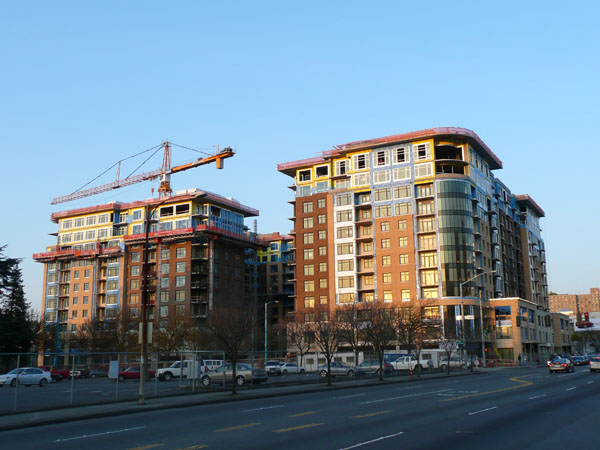
[ Mirabella senior housing ]
Sunday, April 27, 2008 | posted by dan bertolet | Comments Off on Tall and Slivery

Above is a rendering of The Aspen, a 17-story, 194-foot tall condo building under construction in Boise. This building is only 32 feet wide at the base — exceptionally narrow for a building of that height. For comparison, 1310 East Union is 40 feet wide, but it’s only 65 feet tall.
Nothing else remarkable about this project as far as I can tell, but worth noting as a good example of an innovative design solution for an awkwardly shaped site.
UPDATE:  Turns out the parking garage was designed from the get-go to be wrapped in building. So to my mind, this building is not innovative infill, but more like lipstick on the pig of car-oriented development.
Sunday, April 27, 2008 | posted by dan bertolet | Comments Off on Lake Union Park
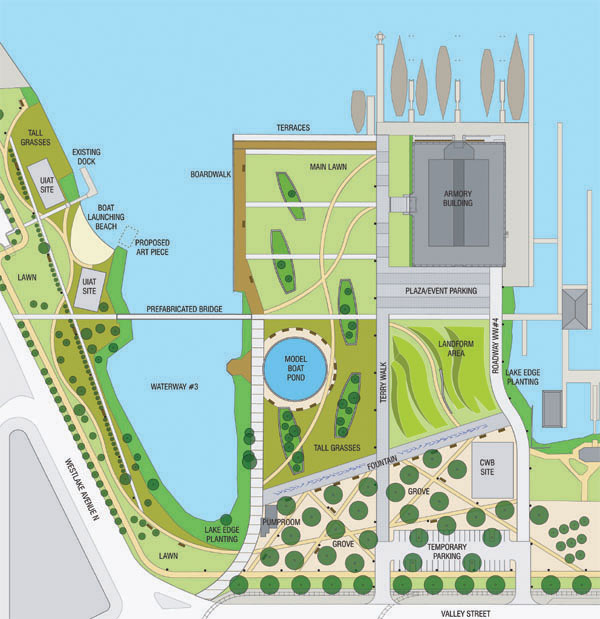
Phase 1 of Lake Union Park opens this Wednesday, April 30, 2008. What’s not to like? And a reason to ride the SLUT.
P.S. I need help covering open space on this blog. If you are interested in contributing please contact me at: hugeasscity@noisetank.com.
Friday, April 25, 2008 | posted by dan bertolet | Comments Off on Good Building

[ Mosler Lofts, at 3rd and Clay in Belltown ]
Every single molecule is right
When all of the subatomic pieces
Come together
And unfold themselves
In a second
— The Flaming Lips
There was some good chemistry with this building, one of those rare projects with just the right combination of people, place, and conditions.
Thursday, April 24, 2008 | posted by dan bertolet | Comments Off on We Don’t Build These Anymore

[ 16th and Howell on Capitol Hill ]
But we should. (I’m talking about the building, though that is a pretty sweet two-tone pickup.)
This apartment provides about twice the housing unit density of today’s typical townhouse 4-pack. And because of its modest scale and substantial setbacks, it would also be less obtrusive in a single-family neighborhood than zero-lot line townhouses are. Yes, the apartment units are much smaller than those in townhouses, but Seattle has a greater need for affordable apartments than for half-million dollar townhouses.
So why aren’t we building any more of these small apartments? Short answer: Cars.
In most Seattle neighborhoods this apartment, if built today, would require 1.1 off-street parking spaces per unit. Most of the first floor of the building would be taken up by parking stalls and the building couldn’t possibly pencil out. So bring on the 4-pack.
Of course, even if the City reduced the parking requirement to zero tomorrow, most housing developers would still not build projects without parking, based on widely held assumptions that housing without parking is not marketable (assumptions with which the lenders tend to agree). But couldn’t we at least allow the possibility?
As greenhouse gas emission regulations become more entrenched, eventually there will come a time when the City will either do away with parking requirements or face lawsuits. But we’d be much smarter not to wait that long, given the massive reductions we need to achieve, and knowing that every car-oriented building that goes up today will likely still be around in 2050, at which time our goal is to have cut vehicle miles traveled in half.
It is astounding to me that even after CO2 has become a household word, and even in liberal Seattle, the most common neighborhood objection to proposed development is that there won’t be enough parking provided. It’s as if people believe there is an inalienable right to park two cars on the street right in front of your house.
Your cars or your planet, people, which is it gonna be?
Wednesday, April 23, 2008 | posted by dan bertolet | Comments Off on Good Read On Regional Growth
Over at Crosscut, former WA State Secretary of Transportation Douglas MacDonald discusses how since 2000, the Puget Sound Region’s urban centers have been capturing a far lower fraction of growth than the PSRC’s Vision 2040 goals. His suggested medicine for rectifying the situation is to make the big cities more attractive, e.g. with better schools, housing, amenities, and, of course, transportation.
Martin at Seattle Transit Blog has posted a spritited rejoinder, pointing out that Seattle does not have a problem with being undesirable, and that a major reason more people haven’t moved to Seattle is a lack of housing supply.
What both of them miss is that more people will move to the urban centers if and when they are faced with the prospect of paying the true costs of not doing so. For reference, see this recent New York Times piece on the negative externalities associated with driving cars. Not to forget the externalized costs associated with habitat destruction and loss of farmland.
Another factor that will likely increase growth in urban centers is the regulation of greenhouse gas emissions. WA State now has a law on the books that targets a 50% reduction of vehicle miles traveled (VMTs) by 2050. State and local governments will be required to enact policy that helps achieve that goal, and there’s no question that a primary policy focus will have to be to discourage growth in low-density outlying regions, while encouraging it in the urban centers. Imagine, for example, a C02 impact fee imposed on low-density development. A fee which is then spent on, let’s say, providing affordable housing in Seattle. Now that would be some potent medicine.
Tuesday, April 22, 2008 | posted by dan bertolet | Comments Off on TOD on MLK
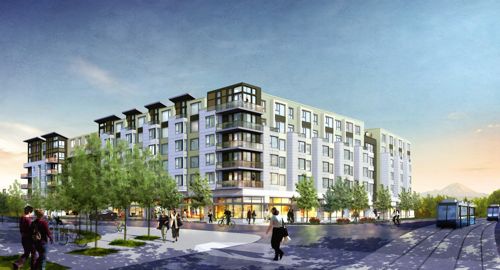
[ “Othello South” rendering by Ruffcorn Mott Hinthorne Stine ]
This widget rocks — the Seattle Times is all over the future of TOD (transit-oriented development) along the Martin Luther King light rail corridor.
“Over the past year private, for-profit developers have proposed more than 1,500 condo and apartment units within a 10-minute walk of a rail station.”
This is why light rail is worth the financial hit — it’s a catalyst for focussed development. It’s unfortunate, however, that none of the proposed buildings exceeds six stories — that’s all the current zoning allows. And the new buildings at Rainier Vista top out at only four stories. Not that we need to go nuts with skyscrapers, but it would make sense for the City to permit something like 10 or 12 stories in certain well chosen locations around the light rail stations. The higher the density, the more dividends on the light rail investment.
(Also note a few more apartments to add to my list, including 400 units in Harbor Properties’ St. Gobain project in Columbia City, and 730 units in Othello Partners’ two buildings at the Othello Station.)
Monday, April 21, 2008 | posted by dan bertolet | Comments Off on Apartments Coming To The Neighborhoods
Today’s PI had a cover story on the shortage and high cost of apartments in Seattle, reporting that average rent is at an all-time high of $1071/month. The market is already responding — see my recent post that summed up 3217 new or planned apartment units coming to downtown Seattle. Below are several more that are new, under construction, or in the planning stages out in the neighborhoods. But even considering the law of supply and demand, it’s seems unlikely that many of these will rent for less than $1071/month.

The Pearl Apartments at 15th and Madison on Capitol Hill; 80 units; Barrientos LLC; designed by Weinstein A/U, who also designed Agnes Lofts, a few blocks West.

AMLI 535, South Lake Union; 199 units; Trammell Crow Residential (sold to AMLI); designed by Weber Thompson (now open).

Alexan Greenlake (Albertson’s site); 205 units; Trammell Crow Residential.

Alexan Ballard on Market St between 15th and 17th Ave; 260 units (in two buildings); Trammel Crow Residential; designed by GGLO.

Park 71 (Vitamilk site), Greenlake; 280 units; Lorig Associates; designed by Hewitt.
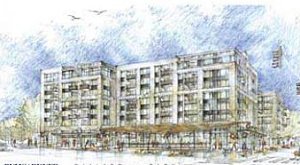
Ballard on the Park (QFC Site) 2237 N.W. 58th St., Ballard; 268 units; Security Properties.

Broadstone Ballard, 1139 NW Market St; 163 units; Alliance Residential.

Thornton Place, Northgate; 238 units (plus condos); Lorig Associates; designed by Mithun.
The Chloe, 14th and Union on Capitol Hill, 117 units, designed by Runberg.
2203 East Union, Central District; 93 units; J C Mueller LLC; designed by Mithun.
2051 East Madison, Central District; 105 units; J C Muiller LLC; designed by Mithun.


































